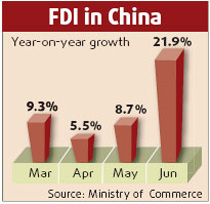A new online textile export license system began operation in China on Tuesday, just days before a quota system for shipments to the European Union (EU) is to expire, sources with the Ministry of Commerce (MOC) told Xinhua.
The online application system "is one of a series of measures taken by China to better regulate the textile export market and avoid a surge of Chinese clothing exports to the EU like the one in 2005," Zhao Qiuyan, a senior analyst with the China Trade Remedy Information website, under the MOC, told Xinhua.
After international textile quotas expired in January 2005, Europe was swamped by low-priced imports from China. That surge led Chinese and EU authorities to sign the Memorandum of Understanding on China-EU Textile Trade, which renewed quotas on China's textile exports to the EU in June 2005. But that pact expires at the end of 2007.
The two sides agreed this September to set up a bilateral system to monitor Chinese exports of T-shirts, pullovers, men's trousers, blouses, dresses, bras, bed linens and flax yarn after the quotas end. Monitoring is to continue until the end of 2008, without quantity restrictions.
Under the system, these eight categories will be tracked on the Chinese side through export licenses and will be monitored when they enter the EU, which is watching for signs of another surge in textile goods from China.
The MOC and the General Customs Administration issued a circular on European-oriented textile exporters' management earlier this month, in which they stipulated that only qualified textile makers could apply to local MOC branches for export licenses, either electronically or on paper.
The China Chamber of Commerce for Import and Export of Textiles, China National Textile and Apparel Council and China Association of Enterprises with Foreign Investment established the standards in November for domestic exporters and formed a joint assessment group.
The standards require exporters to have a minimum registered capital of 500,000 yuan (68,250 US dollars), at least two years of export operation experience and no violations of intellectual property or environmental protection laws.
"The bilateral monitoring system could eliminate the practice of quota trading between some export companies," Zhao said.
The MOC didn't reveal how many qualified exporters had applied under the online system. But experts believe that exporters' quality assessment and license application and approval systems are expected to help reduce the often vicious competition among domestic enterprises.
"China has surplus production capabilities in textile industry and competition is fierce, so we cannot guarantee that Chinese textile exports to the EU wouldn't surge again," Zhao Yumin, a research fellow with the Trade and Economic Cooperation Institute of the MOC, told Xinhua.
Commenting on the possibility of "Made in China" products flooding the EU, Zhao Qiuyan said that besides government efforts, domestic exporters should exercise restraint, since the EU might adopt tightening measures if there was a new surge of Chinese goods.
Under paragraph 242 in the "Report of the Working Party on China's Accession to the World Trade Organization (WTO)", if there is market disruption caused by a surge of textile exports from China, other WTO members are permitted to resume curbs.
This past October, MOC vice minister Gao Hucheng urged Chinese textile makers to develop more in-house brands, streamline their product structure and narrow disparities with international competitors through exchanges and cooperation.
Industry watchers said if the bilateral monitoring system functioned smoothly, it would serve as a good example for dealing with the Sino-US textile quota system, which is set to expire by the end of 2008.
(Xinhua News Agency December 26, 2007)


